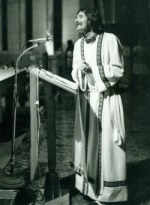Where the spiritual catastrophe began. GoGo Masses of the 60s and 70s.
The GoGo Mass of the 1960s and 1970s: religious, musical and festive celebrations
Les Alléluias performing in Saguenay in 1965.
The revolution in the Catholic Church brought about by the Second Vatican Ecumenical Council (Vatican II) was reflected in the emergence in Quebec, among other places, of "GoGo masses", or rhythmic masses. So popular were these ceremonies that they gave rise to a veritable musical genre, which the Quebec industry has seized upon. Sébastien Desrosiers, music editor and blogger specializing in Quebec's heritage, recounts and explains this epoch-making phenomenon.
In Quebec, some priests didn't wait for the end of Vatican II. As early as 1958, Father Bernard, nicknamed le ménestrel du Bon Dieu, sang the word of Christ on his first record. Father Bernard was inspired by Félix Leclerc, who invited him to open his shows in France in 1959.
Christian rock
Between 1961 and 1965, the group Les Alléluias, led by Bernard Tremblay, united seminarians from the Pères rédemptoristes scholasticate in Aylmer-Est, Outaouais. They released three singles, which met with considerable success. In 1964 and 1965, a tour took them to Saguenay-Lac-Saint-Jean and the Montreal region. At the same time, Les Alléluias recorded at the Maison de Radio-Canada studios in Montreal. The album is a great success.
The first GoGo Masses were held in the spring of 1965, and the movement quickly took off, spreading to churches and records.
A studio in a church
In the 1960s and 1970s, the Cap-de-la-Madeleine sanctuary near Trois-Rivières became the production center for Quebec religious pop. In 1947, the Missionary Oblates of Mary Immaculate inaugurated the Radio-Marie station and studio, which remained in operation until 1979. In 1959, Radio-Marie produces its first muse, Oblate singer and guitarist Jacqueline Lemay. She scored a hit with singles and her first album in 1962.
In 1967, the Radio-Marie record company recruited a young artistic director, Father André Dumont, who was already a songwriter. He developed the Jerusalem collection, a series of recordings created to capitalize on the mass craze.
A Christian rock opera
In 1969, with his show Aimons-nous les uns les autres- Let us love one another, Michel Conte presented an audacious concept built around the Gospels.
"The songs featured the apostle Peter as a grocery store clerk, Mary Magdalene as a waitress in a small restaurant, and Jesus as the leader of a motorcycle gang. It was unimaginable just a few years earlier."
- A quote from Sébastien Desrosiers
With his musicians, Michel Conte performs from church to church for 18 months, dressed in protruding, psychedelic caftans. Paris is even treated to Aimons-nous les uns les autres for a week.
On the small screen
In 1969, Radio-Canada television recruited Capuchin priest and singer Yvon Hubert to host the summer edition of Sunday mass on Le jour du Seigneur, live from Quebec City.
The following year, Yvon Hubert was hired for the same show, but in Montreal. He co-hosts with François Dompierre and his musicians. Yvon Hubert released four albums with François Dompierre, and attracted attention with his show Spirisphère.
In 1972, the rock group Offenbach asked him to officiate an old-fashioned ceremony in Latin for one of their shows. The Rhythmic Mass for the Dead was performed just once, on November 30, 1972, before an audience of nearly 3,000 at St. Joseph's Oratory Basilica.
(I found the Kyrie. It is dreadful.)
Peak and decline
An impressive number of Christian folk, pop and rock bands appeared in the 1970s. The movement fizzled out in the late 1970s and early 1980s.
It may have ended with the visit of Pope John Paul II to Montreal in 1984. The largest rhythmic mass event in Quebec took place at the Olympic Stadium, in front of some 65,000 people.











.jpeg)

Comments